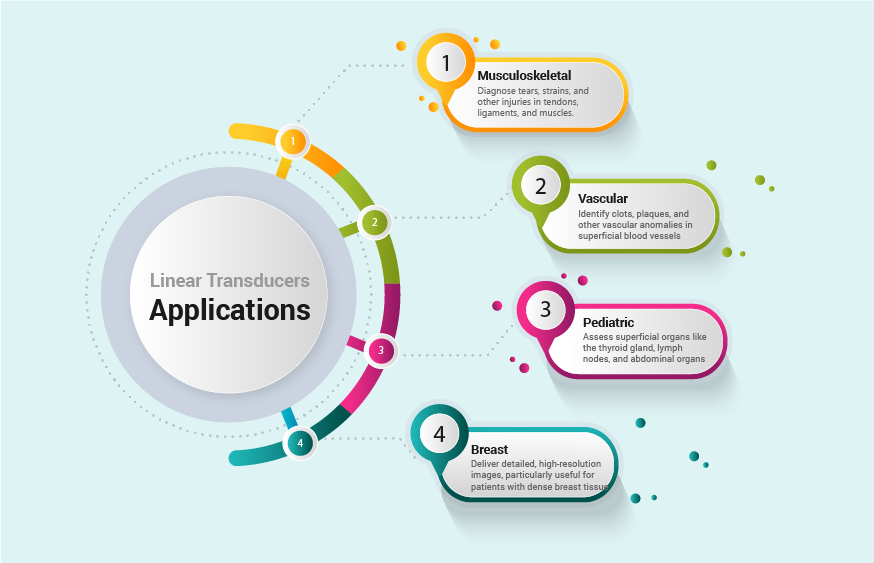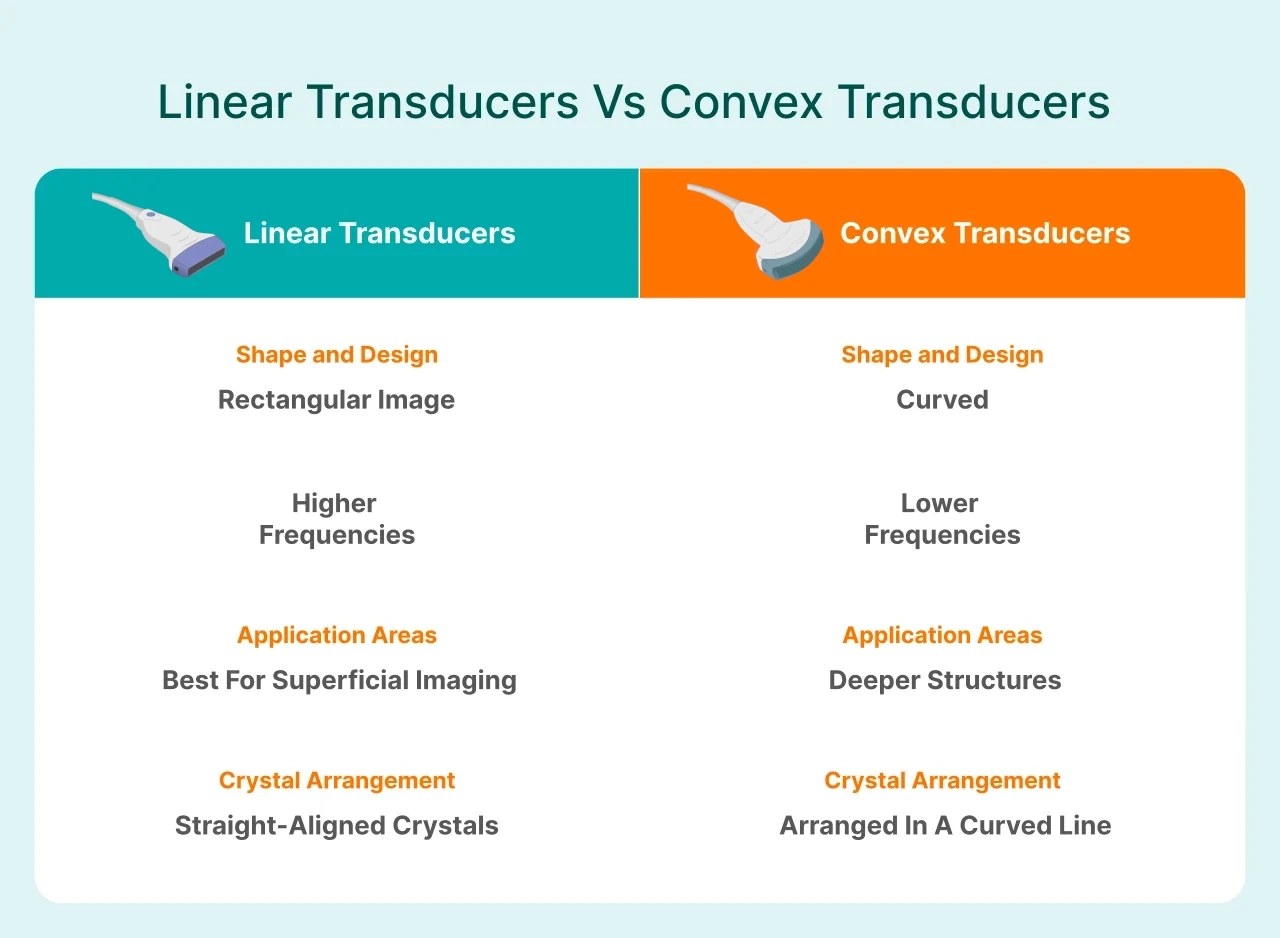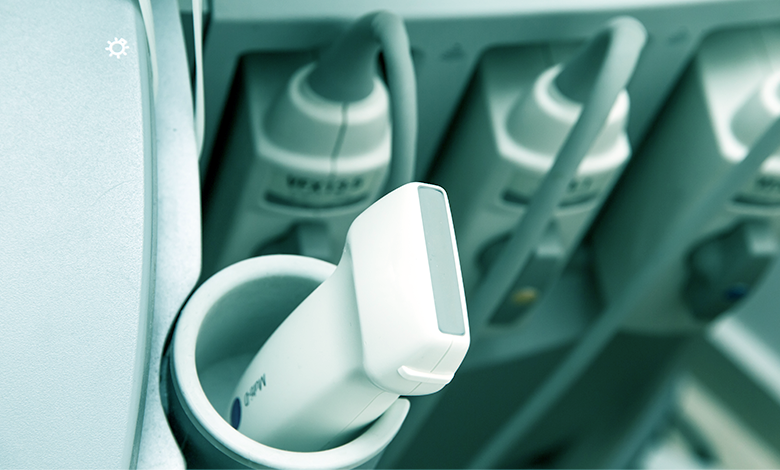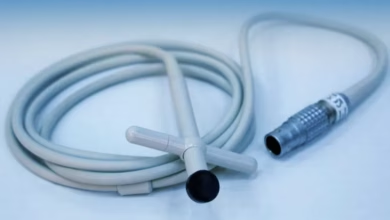What Is a Linear Transducer?
Our previous blog introduced the different types of ultrasound transducers, each designed for specific medical applications. In this blog, we will take a closer look at one particular category: linear transducers. We’ll explore their key features, advantages, and the types of medical procedures that benefit from their use. Let’s get started!
An Introduction to Linear Transducers
A linear transducer is a type of ultrasound transducer or probe known for its high-resolution imaging capabilities. These types of ultrasound transducers have a flat, rectangular shape, making them distinct from other ultrasound transducers. As their name suggests, linear transducers feature a linear arrangement of piezoelectric crystals, which allows them to deliver high-resolution images of internal body parts with a frequency range from 5 to 20 MHz.
Keep reading to discover how linear probes work, as well as their key benefits and applications.
How Does a Linear Probe Work?
All types of ultrasound transducers, including linear probes, receive electrical energy and transform it into mechanical energy. Technically speaking, when the probe or transducer is placed on the patient’s body, an electric pulse is sent from the ultrasound machine to the transducer, causing the piezoelectric crystals inside it to vibrate. These vibrations generate high-frequency sound waves that travel through the body’s structure.
Then, subsequently, the sound waves bounce back to the transducer as echoes, making the crystals vibrate again, which produces electrical signals. These signals are then converted into digital data, allowing different areas of the patient’s body to be diagnosed. The images’ size and quality heavily depend on the types of ultrasound probes. To better grasp, let’s take a look at the example below:
- When a patient comes in for a thyroid examination, the linear transducer is commonly used due to its high-resolution imaging capabilities. It’s placed on the neck to emit sound waves that bounce back as echoes from the thyroid. This creates detailed images, aiding in diagnosing thyroid conditions like nodules, cysts, or early signs of cancer.
What Are the Benefits of Linear Transducers?
Like other types of ultrasound transducers, linear probes play a crucial role in helping healthcare professionals diagnose various areas of the patient’s body. With their ability to produce high-resolution images of superficial structures, such as blood vessels, tendons, and muscles, linear transducers are particularly useful for procedures that require detailed imaging of specific areas.
This makes them an essential tool in fields like vascular diagnostics, musculoskeletal examinations, and small-part imaging, including thyroid and breast assessments. By providing real-time, accurate imaging, linear transducers assist in both diagnosing conditions and guiding procedures such as biopsies and injections.
Linear Probes Applications
As we mentioned above, ultrasound probes are widely used for diagnostic purposes in medical imaging. The use cases of ultrasound transducers heavily depend on crucial factors such as size, shape, and their frequency. For example, linear transducers, which come in rectangular form, provide a wide field of view and can be used for organs like the heart, blood vessels, or MSK (musculoskeletal imaging). Additionally, the use cases of linear probes can depend on whether they are used for 2D or 3D imaging.
Here’s a detailed explanation of linear probes’ key applications for 2D imaging:
1- Musculoskeletal Imaging
The linear transducer provides high-frequency images and can diagnose tears, strains, and other injuries in tendons, ligaments, and muscles.
2- Vascular Imaging
Linear probes are also utilized to identify clots, plaques, and other vascular anomalies in superficial blood vessels.
3- Pediatric Imaging
As mentioned earlier, linear ultrasound transducers can also assess superficial organs like the thyroid gland, lymph nodes, and abdominal organs.
4- Breast Imaging
Linear probes are utilized in ultrasound scans to examine breast tissue and identify abnormalities such as masses or cysts. They deliver detailed, high-resolution images, beneficial for patients with dense breast tissue.

However, linear transducers can also be used for 3D imaging, providing more depth and perspective insights into structures. 3D imaging is widely used when there should be detailed volumetric images, like certain advanced musculoskeletal or breast imaging techniques.
Linear Transducers vs Convex Transducers

Transducers vary based on crystal arrangement, shape, frequency, and footprint. Here’s a comparison of linear vs. convex transducers:
- Shape and Design: Linear transducers create a rectangular image, while convex probes produce a curved one.
- Frequency: Linear transducers use higher frequencies, whereas convex types operate at lower frequencies.
- Application Areas: Linear transducers are best for superficial imaging, while convex probes are used for deeper structures.
- Crystal Arrangement: Linear probes have straight-aligned crystals, whereas convex probes have crystals arranged in a curved line.
Top Brands of Linear Probes in 2025
Linear probes are manufactured by several leading brands worldwide. Below, we highlighted the top brands along with their most popular models:
GE Healthcare
GE is one of the most popular brands for ultrasound systems and transducer devices. Some representative models from this brand are:
- GE 9L‑D: For vascular and small-parts imaging
- GE 12L‑RS: A versatile, broad‑bandwidth linear array for general imaging
Fujifilm Sonosite
Sonosite is well known for point-of-care, portable linear probes. Commonly used models include:
- Fujifilm C11e: Suitable for pediatrics, abdominal (ABD), and also veterinary imaging
- Fujifilm C11x: Designed for abdominal (ABD), arterial, and veterinary cardiology applications
Canon Medical Systems
Canon is a rebranded version of Toshiba. Two Noteworthy linear probes of this brand are:
- Canon PLT-705BT: Designed specifically for peripheral vascular imaging
- Canon PLT-1204BT: Suitable for vascular/small‑parts imaging
Samsung
Samsung’s linear probes are widely used in general imaging, MSK, and vascular diagnostics. Among the frequently used probes, you’ll find:
- Samsung LA3‑16A: For MSK, small organs, and vascular imaging
- Samsung LA2-14A: For small parts, vascular, MSK, and potentially pediatrics, gynecology, and abdominal imaging
Philips
Philips provides a wide range of linear transducers across its premium ultrasound systems (e.g., EPIQ series). This brand stands out with many linear probes, such as:
- Philips C10-3v: For OB/GYN, fertility, and some urology applications
- Philips C5-1: For abdominal, OB/GYN, fetal echo, urology, vascular, interventional guidance, prostate, and bowel imaging
Elzhen: Reliable Source for Linear Probes
As you’ve seen above, we listed some of the top brands for linear probes. Beyond knowing which brands lead the market, the next step is deciding where to buy them or how to keep your current probes in top shape.
Linear probes are available through many suppliers, but Elzhen has earned a reputation as one of the most reliable providers of refurbished probes. You can visit elzhen.com, compare pricing, and conveniently place your order online.
In addition to supplying refurbished probes, Elzhen also offers an innovative probe repair service for customers who already own a probe but are experiencing functional issues. This makes Elzhen a practical choice for both purchasing and maintaining linear probes.
The Bottom Line
All in all, linear ultrasound transducers are highly specialized tools known for their exceptional resolution and ability to produce detailed images of a superficial patient’s body. Their unique flat, rectangular shape and high-frequency range make them particularly effective for musculoskeletal, vascular, and pediatric imaging applications. By providing real-time, precise imaging, linear transducers play a vital role in diagnosing conditions and guiding various medical procedures.
For healthcare providers looking to purchase or repair these probes, Elzhen stands out as a trusted partner with reliable solutions tailored to clinical needs.




